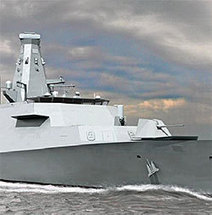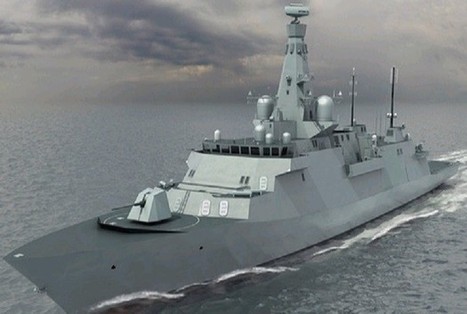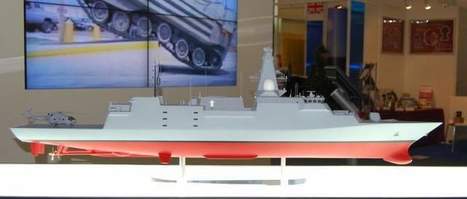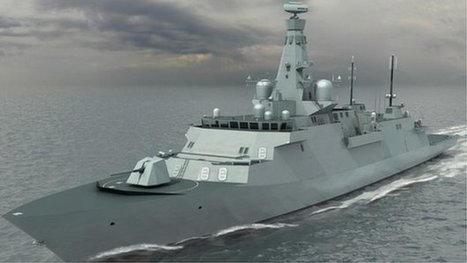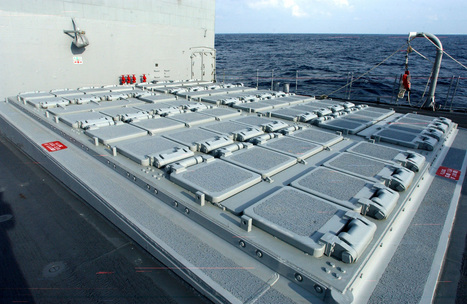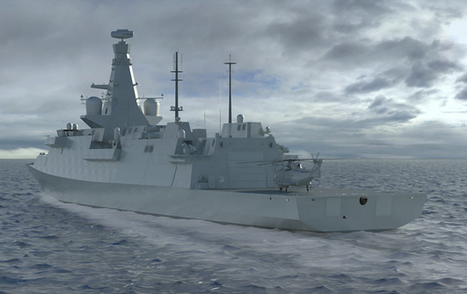 Your new post is loading...

|
Scooped by
Patrick H.
|
The projects most vulnerable to Ministry of Defence cuts are also those most critical to maintaining industry capacity in Britain. They include: Type-26 ships The Type-26 Global Combat Ship will replace the Type-23 frigate as the workhorse of the Royal Navy, with capability for battle, maritime security and international engagement. The first is set to enter service in 2022 and the last will remain operational until 2060. The programme promises to be one of the single most financially burdensome projects for the next government with estimates running to up to as £400m per ship. Current plans are to replace the 13 Type-23 frigate with 13 Type-26 ships delivered in two variants: anti-submarine warfare and general purpose vessels. The government has said the development contract will safeguard 1,700 UK jobs, including 600 on the Clyde, at BAE Systems and in its supply chain. Ministers recently awarded an £859m “demonstration” contract to BAE Systems, the first of its kind to be used for a combat ship, in a move that allows the company to start ordering long-lead items, such as gas turbines, generators and steering gear. The Type-26 programme will sustain the UK’s sovereign ability to design and build warships for the next 20 years, according to ADS, the industry lobby group. Conceding that skills will have to be maintained to ensure future warship building capability, the Ministry of Defence in 2013 awarded a contract to BAE for three offshore patrol vessels, which will provide work between the completion of the Queen Elizabeth Class aircraft carriers and the Type-26.
Trident successor Vanguard-class submarines that carry the Trident nuclear warheads and missiles come out of service in 2028. Their replacement is known as the successor, which will provide a continuous at sea nuclear deterrent. The successor submarine is being developed jointly by the MoD and three industrial partners — BAE Systems, Rolls-Royce and Babcock International. About 2,200 people are working on the successor programme, of whom more than 50 per cent are engineers and designers. The MoD estimates that jobs on the successor programme will peak at 6,000 during the build phase from 2016 to the late 2020s and involve an estimated 850 British companies. If the wider supply chain is taken into account the programmes will support 5,000-17,000 jobs, according to ADS. The main investment decision on successor is expected next year with total costs estimated to be £14bn-£17bn, ADS says.

|
Scooped by
Patrick H.
|
THE Royal Navy's new Type 26 frigates are to be based in Plymouth, it has been announced this morning - but Devonport must share them with Portsmouth. Chancellor of the Exchequer, George Osborne today visited Portsmouth where he set out the government’s next steps in building the most modern navy in the world. On a visit to the home of the Royal Navy, the Chancellor announced a new national shipbuilding strategy in advance of a decision later this year on orders for the brand new Type 26 Global Combat Ship. The Chancellor also announced that these multi-million pound ships will be based at the Navy bases in Portsmouth and Plymouth. As part of the development of the national shipbuilding strategy, the Chancellor has asked to look at the potential to build a new complex warship every two years. As well as maximising export opportunities, this will ensure the Royal Navy continues to have the capability it needs to protect our nation’s interests, retaining its status as the most modern Navy in the world. The strategy will help deliver world class ships for the Royal Navy while ensuring the best value-for-money for the taxpayer. It will also ensure that the Navy continues to have the capability it needs to protect our nation’s interests and ensure continued investment in UK warship production. It will help maintain jobs, provide new apprenticeships, and develop advanced engineering skills. The announcement builds further on the government’s commitment to Defence and the Royal Navy. Today, the Royal Navy is being modernised with new equipment, ships and submarines; it is building two of the second largest new aircraft carriers in the world, which will operate the most sophisticated fighter aircraft ever produced. It will receive the world leading new Type 26 frigate. Two Astute Class submarines, the most advanced nuclear submarines in the world, have already deployed on operations and the UK is working to deliver a further five of the class over the next decade. Combined with the Type 45 Destroyer and four modern tankers to support the fleet at sea, as well as the forthcoming renewal of Trident, this means the Royal Navy of today is being equipped for the challenges of the 21st century. While on the visit to one of the world’s oldest dry docks, the Chancellor also announced almost £100m of infrastructure development in new dock facilities at Portsmouth Naval Base to further support the arrival of the Queen Elizabeth Class Aircraft Carriers. The new work will encompass berthing and jetty improvements, new power supply and distribution, and significant dredging in the approach to the harbour to enable the base to accommodate the largest warships ever built for the Royal Navy. The move will provide significant employment opportunities in the Portsmouth area over the next Parliament.

|
Scooped by
Patrick H.
|
BAE Systems’ Engineers are overhauling their approach to the design and build of Royal Navy warships by using cutting edge virtual reality technology. The Company has constructed a network of ‘visualisation suites’ at their sites in Glasgow, Portsmouth and Bristol, which create full scale 3D ship prototypes, enabling engineering teams to virtually build and test the design of vessels in advance of the first steel being cut. A laser tracking system and interactive wand allows operators to fly through a ship’s design from any angle and the ability to inspect and examine specific areas, equipment and systems, quickly and easily. This means potential engineering issues can be identified and addressed in real time, while the technology also enables greater collaboration and engagement with suppliers and customers, bringing them into the design process at an earlier stage. Mick Ord, Managing Director at BAE Systems Naval Ships business, said: "Visualisation technology is transforming the way we design, build and deliver complex warships. By creating a virtual prototype, we can mature and optimise a ship’s design and gain a real understanding of the vessel and the experience of those serving on board before manufacturing begins." This new tool forms part of our wider investment activity as we create a world class UK naval engineering business. Cheshire-based SME Virtalis was awarded the contract to install the virtual reality technology across the company’s sites. A pilot has been underway since February and the Company has since opened five suites which have played a key role in the design of the Royal Navy’s new Offshore Patrol Vessels, with teams also using the tool to further mature the design of the Type 26 Global Combat Ship.

|
Scooped by
Patrick H.
|
LONDON — BAE Systems is finishing proposals to build a new generation of frigates for the Royal Navy and has begun delivering details of the bid to the British Defence Ministry ahead of a decision expected by the end of the year, company officials said. The Royal Navy is looking to acquire 13 of the Type 26 frigates for a total of roughly £4 billion (US $6.6 billion), with the first of the warships expected to be delivered starting late 2021 to provide what will eventually become the backbone of the fleet out to around 2060. The warships will replace the Royal Navy’s aging Type 23 fleet. “Initial documents to support the business case for Type 26 have been submitted. The process is underway but not finalized yet. We expect that to be complete by the end of the summer,” a BAE spokeswoman said. BAE is concluding a four-year, £150 million assessment phase on the Type 26 this year and hopes to get the development and build phase approved in order to start cutting metal in 2016. The 6,000-ton Type 26 is primarily intended for anti-submarine warfare, but the design gives the Royal Navy the versatility that is essential given its small number of surface combatants — 13 Type 23 frigates and six Type 45 destroyers. “We are planning for a class of 13 ships, but this will be confirmed at the main investment decision, which is expected towards the end of 2014,” an MoD spokeswoman said. BAE’s proposals are based on a 13-ship fleet, but Jeff Searle, the company’s program director, told reporters on June 3 that he “expected a phased commitment” by the MoD. During a parliamentary debate in December, defense procurement minister Philip Dunne said there would be an initial order for eight Type 26s, but the MoD spokeswoman last week would not comment on whether that remained the case. Dunne told Defense News in a recent interview that getting the Type 26 build program under contract was one of his priorities ahead of the general election in May 2015. That’s a view BAE would echo, industry executives said. The Type 26 deal is one of several planned major defense equipment investments that the government is attempting to get approved ahead of the election, a strategic defense review and potentially further defense spending reductions all threatening to impact the sector next year.

|
Scooped by
Patrick H.
|
Destiné à remplacer le VL Sea Wolf sur les frégates du type 23 de la Royal Navy et à équiper leurs futures remplaçantes du type 26, le système Sea Ceptor, de MBDA, poursuit son développement. Deux tirs ont été réalisés avec succès le 29 mai et le 5 juin sur le site d’essais de Vidsel, en Suède. Pour la première fois, l’autodirecteur électromagnétique des missiles CAMM a été utilisé, de même que la double liaison de données permettant de rafraîchir les informations en vol. Selon MBDA, l’essai a démontré la fonctionnalité du système de commande et de contrôle (C2) du Sea Ceptor, notamment sa capacité à traiter des données provenant d’un radar tiers puis de réaliser le contrôle et l’engagement des missiles. Les deux CAMM ont atteint les performances prévues, leur autodirecteur faisant l’acquisition des cibles peu après le lancement et continuant de les traquer jusqu’à ce que les missiles se voient chacun attribuer leur cible. Lire l'intégralité de l'article sur Mer et Marine : http://www.meretmarine.com/fr/content/mbda-deux-tirs-reussis-pour-le-camm
|

|
Scooped by
Patrick H.
|
The Ministry of Defence (MoD) has signed an £859m initial development deal for the next generation of Royal Navy warships to be built on the Clyde. The move will "support progression" towards the manufacturing phase of the new Type 26 Global Combat Ship. The UK government said the contract would safeguard 1,700 UK jobs, including 600 in Scotland, at both BAE Systems and its supply chain. The news came as Prime Minister David Cameron visited BAE Systems at Govan. The Type 26's manufacturing phase is expected to begin in Glasgow in 2016. The first frigate is due to enter service in the early 2020s, with the class of ship expected to remain in service until 2060. 'Substantial investment' The UK government said the deal would involve about 30 companies in the maritime supply chain and enable investment in essential long-lead items, including equipment such as gas turbines, diesel generators and steering gear for the first three ships. Mr Cameron said the contract represented a "substantial investment" in the shipbuilding industry. He added: "Investing in these warships will ensure we continue to keep our country safe, at home and abroad. "As part of our long-term economic plan, we're not just building the most advanced modern warships in the world - we are building the careers of many young people with apprenticeships that will set them up for life." 'Proud heritage' BAE Systems chief executive Ian King said: "We have a long and proud heritage of delivering complex warships in the UK and today's announcement is a significant endorsement of the government's commitment to sustain this important national capability. "Through the Type 26 programme, we are transforming the way we design and manufacture naval ships with innovative new technologies, leading-edge processes and modern infrastructure. "New ways of working ensure we can continue to deliver the highest quality equipment at the lowest possible cost and compete effectively for future UK and international orders." David Hulse, national officer of the GMB union, said: "This announcement is very good news in that it secures the future of the Clydeside shipyards and the skilled workforce and will enable the company to provide a substantial number of much-needed apprenticeships." Shadow defence secretary Vernon Coaker said: "Following this Tory-led government's substantial delay in approving this contract, it is now crucial that the programme runs on budget and on time."

|
Scooped by
Patrick H.
|
UK Secretary of State for Defence Michael Fallon has confirmed the selection of the strike-length Mk 41 Vertical Launch System (VLS) to meet the Flexible Strike Silo requirement for the Royal Navy's next-generation Type 26 Global Combat Ship (GCS). Each ship will be fitted with three eight-cell modules in a silo sited forward of the bridge. Fallon confirmed the decision to install a 24-cell Flexible Strike Silo fitted with Mk 41 launchers in a written response to Rory Stewart MP, chairman of the House of Commons Defence Committee. His statement said the VLS infrastructure "will be able to accommodate a range of missiles from long-range strike weapons (such as the Tomahawk land attack missile) to anti-ship missiles and anti-submarine rockets with the weapon payload being reconfigured to meet changing threats and missions".

|
Scooped by
Patrick H.
|
Now that Scotland has voted ‘NO’ and paved the way for further Ministry of Defence work in Scotland, the defence giant BAE have announced that the contract to build the £200 million frigate construction facility will be put out to tender next week. According to STV, where this news first broke, this will happen within the next few days. BAE Systems told STV they intend to press ahead with developing plans to build a new all-encompassing facility at the site which currently employs more than 700 staff. Sources at the yard say first stage of the process could happen as early as Monday. A BAE spokesman said: “We have been very open that Scotstoun would offer more benefits to our business and our customers. We continue to explore two options for manufacturing facilities investment in Glasgow, subject to consultation and MOD agreement. The first, a single site strategy, involves consolidating all phases of the build process at Scotstoun where a new state-of-the-art complex warship manufacturing facility would be built. The second, a two-site strategy, involves extending and improving existing facilities at both Govan and Scotstoun. The construction of a new facility, as proposed under the single site option, would have a longer lead time than upgrading existing facilities as proposed under the two site option, hence the tender process for the single site option has commenced earlier.” BAE added: “There’s no plans for a loss of jobs with either option.” BAE Systems is also involved in several other major defence projects, including the F-35 Lightning II, the Eurofighter Typhoon, the Astute-class submarine and the Queen Elizabeth-class aircraft carriers.

|
Scooped by
Patrick H.
|
The shake up of the armed forces is well underway, with the UK moving forward with plans for its future of defence and security. This has seen numerous projects announced and completed for use on the land, in the air, and sea. One of the biggest recent procurement projects going through the system is the replacement of the Royal Navy's Type 23 frigates. The al-new replacement Type 26 will also have a primary role as a specialist anti-submarine warfare ship, but it will be expected to be inherently flexible in capability and able to carry out a wide range of roles.
"The Type 26 will be a world-beating 'best of technology' naval ship capable of a whole range of joint operations," says Brian Johnson, UK business development manager for prime contractor BAE Systems Naval Ship. "Its primary role will be to enable maritime manoeuvres by providing anti-submarine and anti-surface warfare protection to task groups and carrier strike forces. But it will also be able to undertake a broad range of other military tasks, from maritime security and stabilisation roles through to disaster relief and humanitarian operations.
"The Type 26 will be able to support troops ashore with surveillance, gunnery and helicopters and will be as capable in anti-submarine warfare as it will securing against pirate attack off the East Coast of Africa or drug smuggling in the Caribbean."
Designing a warship
The ship has been designed using the latest in 3D CAD and virtual reality software. This has allowed design engineers to project in full size the size and layout of rooms and compartments and walk through the ship in full 3D. This has proven invaluable on previous programmes, including the Astute Class of Submarines and the Type 45 Destroyers.
"The use of 3D visualisation can make sure the layout is as effective as possible, and give engineers a dynamic and collaborative environment in which to work," says Johnson. "We also use this to produce virtual prototypes, so the shipbuilders can look at it and plan the most efficient way to build it."
The Type 26 is being designed to operate as part of a large task group as well as on independent manoeuvres. The vessel will be slightly larger than the Type 23, having a basic displacement of around 6,000 tonnes and length of 150m, but will require fewer crew, expected to be around 115. It will also have a similar range at around 7,000 nautical miles.
A key feature of the ship, and what makes it stand apart from other surface warships around the world, is its mission bay. This flexible space can be used for a wide range of roles and payloads and is at the heart of the Type 26's multi-mission and flexible operational capability.
"The mission bay can carry a range of payloads, from small boats for maritime security to unmanned underwater, surface and air vehicles," says Johnson. "The wide range of modular mission loads include medical facilities for disaster relief, operation control rooms for unmanned vehicles and a wide range of other potential loads. It is a capable space that we can adapt to the future needs of modern warfare as we need."
The ship also features a specially-designed acoustically-optimised hull that produces a low wake by cutting a smooth and quiet path through the water. The hull form and the propeller design were fundamental to the capability of the ship in its anti-submarine role.
"As this is an anti-submarine vessel, we want the hull to produce the minimum amount of noise that we can," says Johnson. "So the shape of the hull will ensure a very smooth flow of water around it and minimise turbulent water in the ship's wake. There has been extensive work to optimise it both virtually and using physical prototypes and models."
The shape of the ship is also characterised by clean flat lines that minimise its radar signature. In addition, the ship is able to run its engines in electric mode for near-silent operation. However, it avoids the use of batteries and instead opts for two diesel generators to operate the propellers on the induced electrical power.
"You can isolate the noise the diesel generators produce by putting them on acoustic mounts, in enclosures and so on," says Mark Dannatt, the director of GE Power Conversion's Naval Business.
Two Rolls-Royce MT30 gas turbine engines are used as the primary power plant. These turbines, when engaged, drive two propellers, with each gas turbine going through a splitting gearbox and then into a secondary reduction gearbox to then drive the two separate propeller shafts. These are isolated from each other to avoid single point failure. Fully engaged, the ship is expected to reach a speed of 28 knots.
The vessels will be also be equipped with a flight deck capable of operating a Chinook helicopter if necessary. The corresponding hangar isn't quite that large but will be able to accommodate both Wildcat and Merlin helicopters. The flight deck also includes an additional hangar door, and space, to accommodate the expected increase in the deployment of Unmanned Aerial Vehicles (UAV).
As a specialist anti-submarine warfare ship the primary sensor to be used will be the powerful Thales 2087 towed array sonar, which has proven its performance on the existing Type 23's. However, each Type 26 will be fitted with an additional Type 2050 bow sonar underwater systems, also built by Thales.
Programme update
At present the Type 26 is four years in to development, taken up predominantly by the honing of capability and designing the ships systems. Prime contractor BAE Systems is now finalising proposals, putting more parts of the ship out to tender, and announcing primary partners and suppliers.
"We are in to the second phase and the team has built up a huge amount of momentum on the programme," says Johnson. "We are increasing the maturity of the design and getting more confidence.
"We are currently in the process of finalising our proposals to the MoD for the programme, with investment decisions to take place at the end of this year, where we'll secure the manufacturing contract of the Type 26 [13 are expected to be ordered].
"There will be in the region of £7 billion of contracts in the supply chain so it's a very significant programme for the UK."
BAE Systems is intending to invest in a new world class manufacturing facility in its Scotstoun shipyard in Glasgow to fulfil the type 26 build programme. Production of the first ship is earmarked to begin in May 2016 with the first ship to enter service in 2021, with the next 12 ships to follow on a 12-month build and repeat schedule. The ships will be in service until 2060.
Geoff Searle, Type 26 global combat ship programme director at BAE Systems, says: "By the 2030's, the Type 26 will be the backbone of UK's surface fleet and a strong industrial base is essential to sustaining this naval capability.
"UK suppliers are expected to account for around 80% of this significant programme." Author
Justin Cunningham

|
Scooped by
Patrick H.
|
BAE Systems has today announced new design contracts for the Type 26 Global Combat Ship, which will play a vital role in the programme to deliver the Royal Navy’s next generation surface warship. Six Design Development Agreements have been awarded covering key areas such as propulsion, ventilation and electrical equipment, as well as combat and navigation systems. The design contracts have been awarded to the following companies:
• Babcock for the ship’s Air Weapons Handling System
• DCNS for work on the vessel’s propulsion shaftlines
• GE Energy Power Conversion for the Electric Propulsion Motor and Drive System
• Imtech for the Heating, Ventilation and Air Conditioning System, and the Low Voltage Electrical equipment
• Raytheon to develop the Integrated Navigation and Bridge Systems
• Tyco Fire & Integrated Solutions for the ship’s Fixed Firefighting Systems
Geoff Searle, Type 26 Global Combat Ship Programme Director at BAE Systems, said: “By the 2030s, the Type 26 will be the backbone of UK’s surface fleet and a strong industrial base is essential to sustaining this naval capability. Our partners and suppliers play a key role in this, as we work together to further develop the detailed design of the ship’s systems and equipment to enable us to deliver 13 highly capable, affordable and supportable Type 26 ships for the Royal Navy. "With UK suppliers expected to account for around 80% of this significant programme, Type 26 will support thousands of skilled UK jobs in BAE Systems and across the whole supply chain. We look forward to welcoming more suppliers into the Type 26 team in the coming months.”
The latest contract awards build on the first four suppliers to the programme announced in September 2013. Covering propulsion and communications equipment for the ship, the initial Design Development Agreements were awarded to Rolls Royce, MTU, David Brown Gear Systems and Rohde & Schwarz. It is expected that a total of 25 agreements will be placed this year.
The Assessment Phase for the Type 26 programme began in March 2010 and a joint team of more than 650 people from across BAE Systems and wider industry are working with the Ministry of Defence on the engineering of the ship and to prepare proposals to be submitted later this year. The team aims to secure a manufacturing contract that will sustain this long-term national capability by the end of 2014.
Under current plans, 13 Type 26 ships will be delivered to the Royal Navy, with manufacturing in Glasgow scheduled to start in 2016. The first vessel is due to enter service as soon as possible after 2020 and the Type 26 class will remain in service until 2060.
The Type 26 Global Combat Ship will be a globally deployable, multi-mission warship capable of undertaking a wide range of roles from high intensity warfare to humanitarian assistance, either operating independently or as part of a task group.
The ship will take full advantage of modular design and open systems architecture, ensuring it can be easily upgraded as new technology develops and can accommodate different sub-systems and equipment suited to potential overseas customer needs.
|



 Your new post is loading...
Your new post is loading...

